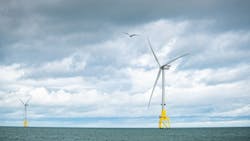Seabirds adjust flight paths around North Sea wind farm
Offshore staff
LONDON — Research used to track bird flight at the European Offshore Wind Deployment Centre (EOWC) in Aberdeen has delivered insights into the flight behavior of seabirds, according to offshore wind farm developer Vattenfall.
The company commissioned the €3 million ($3.1 million) research project, which involved radar tracking of birds flying toward the EOWC, also known as its Aberdeen offshore wind farm, comprising 11 wind turbines. This in turn activated cameras and generated 3D flight tracks and video footage, used to identify the species of birds as they moved through the wind farm and to monitor whether they altered their flight path around the turbines.
The study provided data on the flying patterns of kittiwakes, herring gulls, black-backed gulls and gannets around the facilities, with no collisions or near-misses recorded in more than 10,000 bird videos over a two-year period from 2020 to 2021.
Most of the tracked birds avoided the zone of the turbine blades by adjusting their flight path, flying in between the turbines, often in parallel to the plane of the rotor. This pattern applied to all three species of large gulls.
Kittiwakes displayed avoidance behavior from about 150 m from the rotors; herring gulls from about 100 m and feeding herring gulls from 70 m. Typically, gannets and small and large gulls tended to avoid flying into the area swept by the turbine blades.
These results, Vattenfall suggested, could help speed the consenting process for future wind farms by providing more accurate information on the risk of bird collisions.
Research was focused on seabird flight behavior during the breeding and post-breeding period (April-October) when bird densities were said to be highest in the Aberdeen area.
02.28.2023
